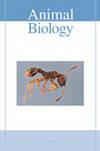猫的气味世界:在哪里放置尿液气味标记以增加信号的持久性?
IF 0.9
4区 生物学
Q2 ZOOLOGY
引用次数: 6
摘要
气味标记是猫科动物交流的主要形式,其中尿液喷洒起着关键作用。气味标记的可检测性和持久性被认为是影响气味标记效率的关键因素,但对各种环境因素对气味持久性的测试研究有限。我们使用一个实验框架来测量人类对猫尿气味的感知强度,并确定标记表面的基底、倾斜和方向对模拟气味标记持久性的影响。我们使用曲线下面积(AUC),计算每个气味标记表面随时间的气味强度,作为尿液气味保存的代表。随后,我们使用方差分析,然后分析标记位点之间的兴趣差异,以评估环境因素对人类感知气味标记持久性的影响。在粗糙表面、苔藓覆盖表面和悬垂倾斜表面上,气味保持得更好,而在朝北和朝南的表面上没有显著差异。研究结果与世界各地野生猫科动物标记地点的使用和选择基本一致,证实了猫科动物在标记行为中努力延长气味标记的持久性。这些知识将有助于研究人员解释气味标记的数据,并评估这种行为的适应性意义。本文章由计算机程序翻译,如有差异,请以英文原文为准。
The scent world of cats: where to place a urine scent mark to increase signal persistence?
Scent-marking is a predominant form of communication among felids, with urine spraying having a key role. Detectability and longevity of scent marks are recognized as crucial for efficiency of scent-marking, but there is limited research that has tested scent persistence with respect to various environmental factors. We used an experimental framework to measure human-perceived strength of felid urine smell and determine the effects of substrate, tilt and aspect of marked surfaces on persistence of the simulated scent marks. We used area under the curve (AUC), calculated for the scent strength of each scent-marked surface over time, as a proxy for urine scent preservation. Thereafter, we used ANOVA, followed by analysis of differences of interest between the marking sites, to assess the effect of environmental factors on human-perceived scent mark persistence. Odour persisted significantly better on rough surfaces, surfaces covered with moss and on surfaces with overhanging tilts, while there was no significant difference between the northerly- and southerly-oriented surfaces. The results are generally in accordance with the use and selection of marking sites previously reported for wild felids throughout the world, confirming that in their marking behaviour felids strive to prolong the persistence of scent marks. This knowledge will help researchers in interpretation of data on scent-marking and to evaluate the adaptive significance of this behaviour.
求助全文
通过发布文献求助,成功后即可免费获取论文全文。
去求助
来源期刊

Animal Biology
生物-动物学
CiteScore
2.10
自引率
0.00%
发文量
34
审稿时长
3 months
期刊介绍:
Animal Biology publishes high quality papers and focuses on integration of the various disciplines within the broad field of zoology. These disciplines include behaviour, developmental biology, ecology, endocrinology, evolutionary biology, genomics, morphology, neurobiology, physiology, systematics and theoretical biology. Purely descriptive papers will not be considered for publication.
Animal Biology is the official journal of the Royal Dutch Zoological Society since its foundation in 1872. The journal was initially called Archives Néerlandaises de Zoologie, which was changed in 1952 to Netherlands Journal of Zoology, the current name was established in 2003.
 求助内容:
求助内容: 应助结果提醒方式:
应助结果提醒方式:


